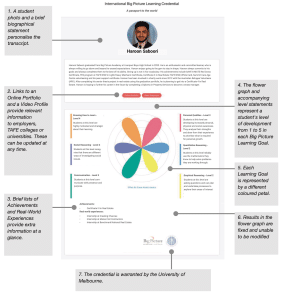Reinventing the Traditional HS Diploma: International Big Picture Learning Credential
CompetencyWorks Blog
This post is the second in a series based upon a report from the Aurora Institute, Going Beyond the Traditional: Next Gen Credentials and Flexible Learning Pathways, which seeks to deepen state policy makers’ understanding of the changes needed to facilitate meaningful next generation (“next gen”) credentials and advance state policy to support those changes.

The International Big Picture Learning Credential (IBPLC) began as a next gen credential and an alternative pathway to the traditional Australian diploma. It supports students with a personalized approach to interest-driven learning in and out of school and enables multiple pathways for future success. Learning pathways are competency-based and unique for each learner. The IBPLC records knowledge, skills, competencies, and achievements across multiple learning environments and opportunities while also highlighting each young person’s goals and ambitions. The IBPLC was developed in Australia in partnership with researchers at the University of Melbourne who validated the competency framework and assessment processes to support quality assurance.
IBPLC Design
The IBPLC is, at its heart, a graduate learner record documenting complex, real-world learning in their final years of schooling. It is rooted in six core competency areas that the IBPLC’s parent organization, Big Picture Learning Australia (BPLA), believes broadly support the Australian Curriculum:
- Knowing how to learn
- Personal qualities
- Quantitative reasoning
- Empirical reasoning
- Communication
- Social reasoning
Each learner builds a Learner Profile that functions like a digital learner record in place of a traditional transcript and provides the evidence needed to earn the IBPLC. Students showcase their learning in the Learner Profile, which end users, such as employers, apprenticeships, and higher education institutions also can view.

The Learner Profile contains many important elements, including:
- Portfolio
- Learning Goals
- Skills and Proficiencies
- Accreditation
- Personal Statement
- Evidence of Learning
- Video
- Advisor Statement
Everything included in the Learner Profile is handpicked and curated by the student with their support team, including community members, teachers, and more. It summarizes their learning, highlights their strengths, and presents a vision of who students are and want to be.
Design of the Big Picture Learning System
The IBPLC is a natural extension of the Big Picture Learning design, which began at the Met School in Providence, Rhode Island. Central practices in the design implementation include advisories and internships in competency-based environments designed to see each learner as an individual. At the center of the credential is the semester-long Individualized Learning Plan, created by the student with the aid of teachers, family members, mentors, and community members. From there, learners complete courses and internships, attend external experiences, and learn skills to meet their objectives. Students also have other requirements for their plans. One requirement is Advisory, where students learn about themselves – their strengths, areas of growth, and needs – along with socializing, making connections within the community, and learning about transitioning into adulthood.

Students collect substantial evidence for portfolios that they present each term to community members such as industry professionals, teachers, parents, and employees. Assessment is competency-based rather than norm-based – students are judged on their mastery of a subject rather than on how they compare to other students at their level of school. Students can achieve five levels of mastery through multiple methods of assessment that include “observation, discussion, demonstration, and exhibition.” For example, for the social reasoning competency, levels include:
- Level 1: Students at this level can describe the social frameworks and systems they are embedded in.
- Level 2: Students at this level recognize that there are different ways to investigate social issues.
- Level 3: Students at this level investigate social issues in depth by applying a range of tools.
- Level 4: Students at this level recognise the connections and distinctions between social issues through systematic investigation.
- Level 5: Students at this level define and analyze social issues using relevant frameworks and perspectives and take responsible social action.
The assessment process is thorough for each competency and is quality assured in partnership with the Assessment Research Centre at the University of Melbourne. The Centre and BPLA designed the 5-level Assessment Frames that describe the developmental progression for each Learning Goal. The Advisors who are responsible for the assessments engage in extensive moderation work to ensure consistency across schools in applying the Assessment Frame rubrics for each of the six competency areas. The Assessment Research Centre also audits the assessment annually for validity and reliability.
Practice assessment for the credential begins in Year 11 for preparation for their final year of high school. However, assessment for the credential does not take place until the final year of schooling. In their final year of school, upcoming graduates also complete a capstone assignment – either a Senior Project or Senior Thesis – to showcase their detailed understanding of their chosen field of study for their internship.
Watch the below video to learn more about the International Big Picture Learning Credential:
The Resulting Credential: IBPLC
Today, the IBPLC has spread widely around Australia and is beginning to launch internationally, including in the United States, Kenya, and Barbados. From its pilot in 2020 with 25 students, the program is growing significantly, with 260 graduating students across Australia with the credential in 2022. In the 2022 group, 100% of students who applied to university received at least one offer. At least 17 public universities accept the credential as equal to the traditional diploma. Today, the IBPLC is used in 44 schools and by over 800 students. In addition, 150 students are in the current IBPLC pilot program in the United States.
To learn more about Big Picture Learning or the International Big Picture Learning Credential, visit their website.
Read the Other Posts in the Series
- Rethinking the High School Transcript for the Future of Learning
- Reinventing the Traditional HS Diploma: New Zealand
- Reinventing the Traditional HS Diploma: Mastery Transcript Consortium ®
Learn More
- International Big Picture Learning Credential (IBPLC): Putting the Person Back in Educational Assessment
- Structuring Schools to Enable Deep, Student-Centered Learning in Real-World Settings
 Alyssa Weaver is the Policy Research Intern at Aurora Institute’s CompetencyWorks program. She is finishing her second master’s degree in public policy at the University of Chicago, where she focuses on education policy. She is a board member of the Education Policy Student Association and a production assistant for Pencils Down, the University of Chicago Public Policy Podcast’s show about education policy. She was a former educator of seven years and taught informal science education, preschool, and most recently, 5th-grade math. She has spoken at conferences and schools on COVID-19 learning loss, project-based learning, multidisciplinary STEM integration, and green spaces for equity. She has recently been published on Bored Teachers, Medium’s Educate., and Medium’s Chicago Education Advocacy Cooperative.
Alyssa Weaver is the Policy Research Intern at Aurora Institute’s CompetencyWorks program. She is finishing her second master’s degree in public policy at the University of Chicago, where she focuses on education policy. She is a board member of the Education Policy Student Association and a production assistant for Pencils Down, the University of Chicago Public Policy Podcast’s show about education policy. She was a former educator of seven years and taught informal science education, preschool, and most recently, 5th-grade math. She has spoken at conferences and schools on COVID-19 learning loss, project-based learning, multidisciplinary STEM integration, and green spaces for equity. She has recently been published on Bored Teachers, Medium’s Educate., and Medium’s Chicago Education Advocacy Cooperative.